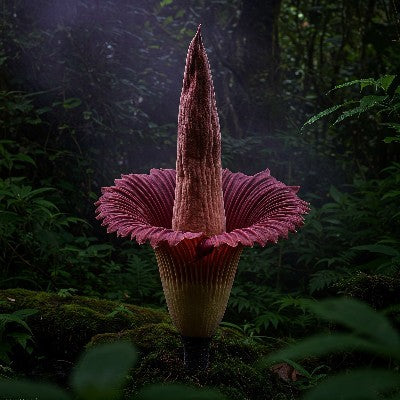Menu
-
-
F.A.Q
- How to identify genuine agarwood chip, natural or cultivated
- How to identify oil injection / absorption fake agarwood beads
- How to know if there are more than one oil in your oil
- How to make your wood bracelet or mala darker
- How to tell if an Agarwood bead sinks WITHOUT sinking it under water?
- How does back flow incense work and how do you burn it?
- Where to start if you don't know what agarwood is ?
- Why are you losing money if you buy seeds and plants?
- Which agarwood incense should I choose?
- Frequently Asked Questions
- Agarwood Related Articles
- Shipping
-
SHOP - Agarwood
-
SHOP - Other Fragrant Wood
-
SHOP - Incense Holder and Burner
-
- FREE Oud Oil guide
- Testimonials
- "Why did you buy this?"
- Contact us
- About Us
- +61430284329
- Login
-
English


Do we like to smell good and nasty scent? It turns out we may like both.
January 31, 2025 4 min read

The Amazing (and Smelly) Putricia, the Corpse Flower
Imagine waiting in line for hours just to smell something that stinks like rotting meat. Sounds crazy, right? But that is exactly what thousands of people did at the Royal Botanic Garden in Sydney when Putricia last week, the famous corpse flower, finally bloomed. By the way
- In November 2024, over 20,000 people came to Geelong to see and smell it at Geelong
- Jan 2023, people also lined up to smell it at Adelaide Botanic Garden
The corpse flower, officially called Amorphophallus titanum, is one of the rarest and biggest flowers in the world. It only blooms once every seven to ten years, and when it does, it releases a strong smell that is best described as 'something died in there.' It might sound awful, but people are fascinated by it.
You can read the full story here.
Putricia, the Corpse Flower, is a fascinating and unique plant with several interesting facts:
- Rarity: Corpse flowers are incredibly rare, and their blooming is an infrequent event, sometimes occurring only once every few years. This makes each bloom a significant botanical event.(Discover Wildlife)
- Size: The Corpse Flower, scientifically known as Amorphophallus titanum, boasts the largest unbranched inflorescence of any plant in the world. This means it has the largest collection of flowers on a single structure, which can reach up to 3 meters tall (Arboretum Harvard)
- Smell: The Corpse Flower is infamous for its overpowering stench of rotting flesh, hence its nickname. This pungent odour is a clever evolutionary adaptation to attract pollinators like carrion beetles and flies (United States Botanic Garden).
- Short Bloom: The bloom of a Corpse Flower is a fleeting spectacle, lasting only about 24-48 hours. This short window of opportunity adds to the allure and mystique of the flower (City Of Greater Geelong)
- Life Cycle: The Corpse Flower grows from an underground stem called a corm, similar to a giant potato. The corm produces a single leaf that can grow up to 5 meters tall and live for over a year, gathering energy for the eventual bloom.
-
Endangered Species: Native to the rainforests of Sumatra, Indonesia, the Corpse Flower is an endangered species due to habitat loss. Conservation efforts are crucial to protect this unique plant.
These facts make Putricia, the Corpse Flower, a truly remarkable botanical wonder, captivating the attention of plant enthusiasts and the general public alike. Its rarity, size, smell, and short bloom time all contribute to its allure and make it a symbol of the fascinating and sometimes bizarre world of plants
Why Do People Want to Smell Something So Bad?
It is all about curiosity. The corpse flower is so rare that when one blooms, it becomes an event. People want to say they were there, that they saw it, and, of course, that they smelled it. Something is thrilling about experiencing a scent so awful yet so famous.
But there is also a scientific reason behind it. The corpse flower does not stink just for fun; it is part of its survival strategy. The foul odour attracts flies and beetles, which help pollinate the flower. Instead of using bees, like many other plants, the corpse flower tricks insects that love decaying things into helping it reproduce. It is nature being clever weirdly and wonderfully.
Why am I telling you this?
Because on the complete opposite end of the scent spectrum, there is another natural rarity: agarwood. While the corpse flower shocks people with its horrible smell, agarwood is one of the most prized and luxurious scents in the world.

Agarwood, also known as oud, comes from the resin of the infected Aquilaria tree. When the tree gets infected with a special type of mould, it defends itself by producing a dark, fragrant resin that smells rich, woody, and deeply calming. This process takes years, making high-quality agarwood rare and valuable. Unlike the corpse flower, which blooms and fades in just a couple of days, agarwood’s aroma can be "stored" for later use. Agarwood aroma can be in the form of incense, oil, and perfumes.
The Fascination with Both the Foul and the Fragrant
The human love for scents—both pleasant and repulsive—is nothing new. While thousands queue up to experience the corpse flower’s revolting odour out of curiosity, history shows that people have also sought out strong, complex, and sometimes overpowering aromas like agarwood for centuries. In many cultures, agarwood has been burned in religious ceremonies, used in perfumes, and prized for its deep, almost hypnotic fragrance. It is a scent that lingers, captivating those who encounter it.
Even outside of agarwood, humans have long embraced powerful and even unusual scents. Think of aged cheese, fermented fish sauces, or truffle mushrooms—all of which have intense, sometimes off-putting smells, yet are considered delicacies. The same principle applies to aroma: we are drawn to scents that are extreme, whether they are shockingly bad or irresistibly good.
Two Rare Gifts from Nature
The corpse flower and agarwood could not be more different, yet they both show how amazing nature can be. One grabs attention with its putrid, overwhelming stink, while the other is cherished for its deep, luxurious scent. Both are rare, both are special, and both remind us that nature is full of surprises.
At Grandawood, we celebrate the wonders of natural aromas—not the shocking, stomach-turning kind, but the kind that has been treasured for centuries. If you love unique scents and want to experience nature’s finest, check out our collection of agarwood products. Unlike the corpse flower, which disappears quickly, agarwood lets you enjoy a rare and beautiful fragrance every day.
Leave a comment
Comments will be approved before showing up.
Also in News

What is Tasbih? The Deep Meaning of Subhan Allah and the Role of Prayer Beads
November 09, 2025 4 min read
